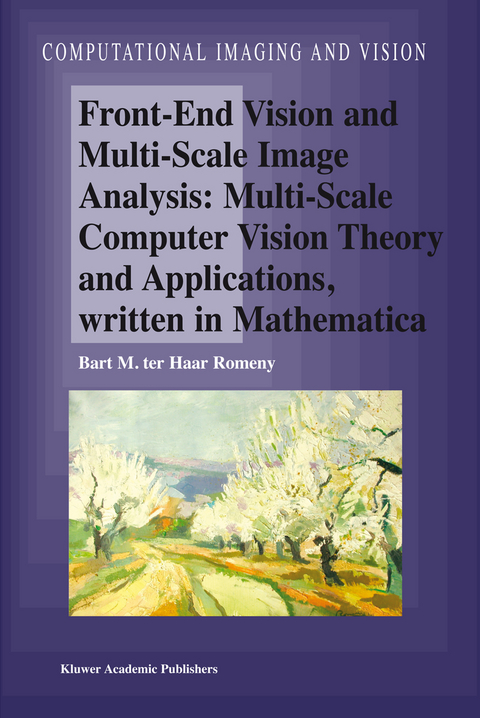Front-End Vision and Multi-Scale Image Analysis
Multi-scale Computer Vision Theory and Applications, written in Mathematica
Seiten
2003
Springer-Verlag New York Inc.
978-1-4020-1507-6 (ISBN)
Springer-Verlag New York Inc.
978-1-4020-1507-6 (ISBN)
Many approaches have been proposed to solve the problem of finding the optic flow field of an image sequence. In this chapter we compute the optic flow as a dense optic flow field with a multi scale differential method.
Many approaches have been proposed to solve the problem of finding the optic flow field of an image sequence. Three major classes of optic flow computation techniques can discriminated (see for a good overview Beauchemin and Barron IBeauchemin19951): gradient based (or differential) methods; phase based (or frequency domain) methods; correlation based (or area) methods; feature point (or sparse data) tracking methods; In this chapter we compute the optic flow as a dense optic flow field with a multi scale differential method. The method, originally proposed by Florack and Nielsen [Florack1998a] is known as the Multiscale Optic Flow Constrain Equation (MOFCE). This is a scale space version of the well known computer vision implementation of the optic flow constraint equation, as originally proposed by Horn and Schunck [Horn1981]. This scale space variation, as usual, consists of the introduction of the aperture of the observation in the process. The application to stereo has been described by Maas et al. [Maas 1995a, Maas 1996a]. Of course, difficulties arise when structure emerges or disappears, such as with occlusion, cloud formation etc. Then knowledge is needed about the processes and objects involved. In this chapter we focus on the scale space approach to the local measurement of optic flow, as we may expect the visual front end to do. 17. 2 Motion detection with pairs of receptive fields As a biologically motivated start, we begin with discussing some neurophysiological findings in the visual system with respect to motion detection.
Many approaches have been proposed to solve the problem of finding the optic flow field of an image sequence. Three major classes of optic flow computation techniques can discriminated (see for a good overview Beauchemin and Barron IBeauchemin19951): gradient based (or differential) methods; phase based (or frequency domain) methods; correlation based (or area) methods; feature point (or sparse data) tracking methods; In this chapter we compute the optic flow as a dense optic flow field with a multi scale differential method. The method, originally proposed by Florack and Nielsen [Florack1998a] is known as the Multiscale Optic Flow Constrain Equation (MOFCE). This is a scale space version of the well known computer vision implementation of the optic flow constraint equation, as originally proposed by Horn and Schunck [Horn1981]. This scale space variation, as usual, consists of the introduction of the aperture of the observation in the process. The application to stereo has been described by Maas et al. [Maas 1995a, Maas 1996a]. Of course, difficulties arise when structure emerges or disappears, such as with occlusion, cloud formation etc. Then knowledge is needed about the processes and objects involved. In this chapter we focus on the scale space approach to the local measurement of optic flow, as we may expect the visual front end to do. 17. 2 Motion detection with pairs of receptive fields As a biologically motivated start, we begin with discussing some neurophysiological findings in the visual system with respect to motion detection.
Apertures and the notion of scale.- Foundations of scale-space.- The Gaussian kernel.- Gaussian derivatives.- Multi-scale derivatives: implementations.- Differential structure of images.- Natural limits on observations.- Differentiation and regularization.- The front-end visual system — the retina.- A scale-space model for the retinal sampling.- The front-end visual system — LGN and cortex.- The front-end visual system — cortical columns.- Deep structure I. watershed segmentation.- Deep structure II. catastrophe theory.- Deep structure III. topological numbers.- Deblurring Gaussian blur.- Multi-scale optic flow.- Color differential structure.- Steerable kernels.- Scale-time.- Geometry-driven diffusion.- Epilog.
| Reihe/Serie | Computational Imaging and Vision ; 27 |
|---|---|
| Zusatzinfo | XVIII, 466 p. With online files/update. |
| Verlagsort | New York, NY |
| Sprache | englisch |
| Maße | 160 x 240 mm |
| Themenwelt | Informatik ► Grafik / Design ► Digitale Bildverarbeitung |
| Informatik ► Theorie / Studium ► Künstliche Intelligenz / Robotik | |
| Technik ► Maschinenbau | |
| Schlagworte | Digitale Bildbearbeitung • Mathematica |
| ISBN-10 | 1-4020-1507-0 / 1402015070 |
| ISBN-13 | 978-1-4020-1507-6 / 9781402015076 |
| Zustand | Neuware |
| Haben Sie eine Frage zum Produkt? |
Mehr entdecken
aus dem Bereich
aus dem Bereich
Modelle für 3D-Druck und CNC entwerfen
Buch | Softcover (2022)
dpunkt (Verlag)
34,90 €
alles zum Drucken, Scannen, Modellieren
Buch | Softcover (2024)
Markt + Technik Verlag
24,95 €




